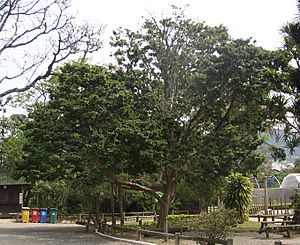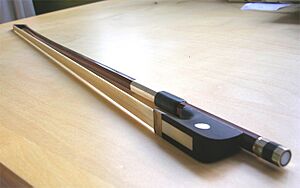Paubrasilia facts for kids
Quick facts for kids Paubrasilia echinata |
|
|---|---|
 |
|
| An adult specimen in a park in Florianópolis, Brazil. | |
| Conservation status | |
| Scientific classification | |
| Genus: |
Paubrasilia
|
| Species: |
echinata
|
| Synonyms | |
|
|
The Paubrasilia echinata is a special kind of flowering plant in the pea family, called Fabaceae. It grows only in the Atlantic Forest of Brazil. This tree is also known as Pernambuco wood or brazilwood. In Portuguese, it's called pau-de-pernambuco or pau-brasil. It's even the national tree of Brazil!
This tree has a strong, reddish-orange wood that can be polished to a high shine. It's the best wood for making bows for musical instruments like violins and cellos. The wood also gives us a red dye called brazilin. This dye was very important a long time ago.
The name pau-brasil was first used for some trees in the Caesalpinia group a long time ago. Its first scientific name, Caesalpinia echinata, was given in 1785. Later studies in 2016 showed it was unique enough to get its own group, so it was renamed Paubrasilia echinata. The word echinata means "like a hedgehog". This is because the tree has thorns all over it, even on its fruits! The country of Brazil got its name from this tree. The full name used to be Terra do Brasil, which means 'land of brazilwood'.
Contents
What's in a Name?
When explorers from Portugal first arrived in South America, they found the Paubrasilia tree. They knew it was related to a tree from Asia called sappanwood, which was already used in Europe to make red dye. The Portuguese called these new trees pau-brasil. Pau means wood, and brasil means reddish or like glowing embers.
Soon, the South American trees became the main source for this dye because they were better. So much wood was traded that sailors and merchants started calling the land itself Terra do Brasil, or "Land of Brazil". This is how the country got its name!
Many trees are sometimes called "brazilwood". They all belong to the Fabaceae family, which is the pea or bean family. The name "brazilwood" usually means Paubrasilia echinata. But it can also mean other trees like Caesalpinia sappan and Haematoxylum brasiletto. The tree is also known as Ibirapitanga, which means "red wood" in the Tupi language. Another name is pau de pernambuco, named after the Brazilian state of Pernambuco.
In the world of making musical bows, other woods are sometimes called "brazilwood". These include pink ipê (Handroanthus impetiginosus), Massaranduba (Manilkara bidentata), and palo brasil (Haematoxylum brasiletto). But the most valuable Paubrasilia echinata is usually called "Pernambuco wood" by bow makers.
Tree Description
The brazilwood tree can grow up to 15 metres (49 ft) (about 49 feet) tall. Its dark brown bark peels off in big pieces, showing the shiny, blood-red wood underneath. The leaves are made up of 9 to 19 small, tough leaflets. These leaflets are shaped like wide rectangles.
The tree's flower stalks have 15 to 40 yellow flowers that smell very strong. Bees often help pollinate these flowers. The petals are usually yellow with a red spot. The fruits are oval-shaped, woody pods. They can be up to 7.3 centimetres (2.9 in) (about 2.9 inches) long. After the seeds fall out, the pods twist. The branches, leaves, and fruits all have small thorns.
Scientists think there might be different types of brazilwood trees depending on where they grow. This tree may also have some medicinal uses. Local people have used it to help with certain health issues. Some parts of the tree have even been studied as possible cancer treatments.
Historical Importance
Starting in the 1500s, brazilwood became very valuable in Europe. It was hard to get. A similar wood, sappanwood from Asia, was used to make a red dye. This dye was important for making fancy fabrics like velvet, which were popular during the Renaissance.
When Portuguese sailors landed in what is now Brazil in 1500, they saw tons of brazilwood trees along the coast and rivers. Within a few years, a busy and very profitable business started. They would cut down the trees and ship the logs back to Portugal. The Portuguese king had a special right to all this wood.
This rich trade made other countries want to get brazilwood too. Some tried to secretly take the wood out of Brazil. Others, like pirates, would attack Portuguese ships to steal their cargo. For example, a French group tried to start a colony in Rio de Janeiro in 1555. One reason was to get rich from brazilwood. This plant is also mentioned in an important book about Brazilian plants called Flora Brasiliensis.
Protecting the Brazilwood Tree
Too much harvesting caused the number of brazilwood trees to drop sharply in the 1700s. This made the wood trade almost disappear. Today, the tree has almost disappeared from many places where it used to grow. The IUCN (International Union for Conservation of Nature) lists brazilwood as an endangered species. It's also on Brazil's official list of endangered plants.
The trade of brazilwood might be stopped soon. This would be a big problem for people who make musical bows, as they really value this wood. The International Pernambuco Conservation Initiative (IPCI) is a group of bow makers who depend on this wood. They are working to plant more trees. IPCI also suggests using other woods for violin bows to help raise money to plant more brazilwood seedlings. Because brazilwood is harder to find, companies that make bows from carbon fiber and other materials have grown.
Replanting Efforts
It's hard to help this tree grow back in the wild. This is because it's a "climax community" species. This means it grows best when planted among other older forest plants. Many young trees have been given away or sold in recent years. But sometimes, they are planted outside their natural areas. This can lead to poor results. For example, brazilwood trees used for city landscaping in São Paulo often don't grow or flower well because the weather is colder there.
Images for kids
See also
 In Spanish: Palo brasil para niños
In Spanish: Palo brasil para niños










